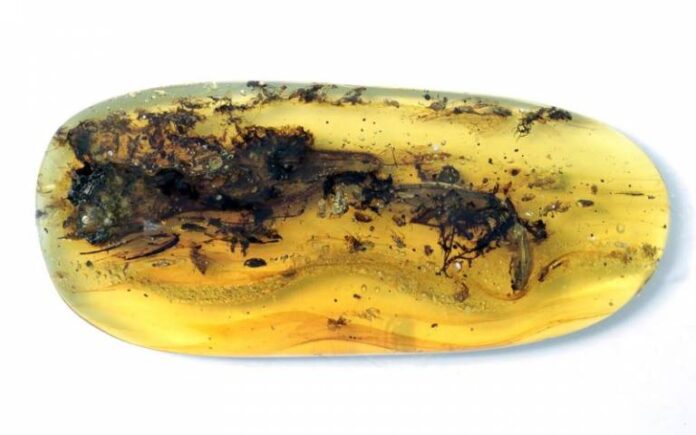An international research team has described a new species of Oculudentavis, providing further evidence that the animal first identified as a hummingbird-sized dinosaur was actually a lizard.
The new species, named Oculudentavis naga in honor of the Naga people of Myanmar and India, and was studied using a partial skeleton that includes a complete skull, exquisitely preserved in amber with visible scales and soft tissue.
The specimen is in the same genus as Oculudentavis khaungraae, whose original description as the smallest known bird was retracted last year. The two fossils were found in the same area and are about 99 million years old.
Researchers have published their findings in Current Biology.
The team used CT scans to separate, analyse and compare each bone in the two species digitally, uncovering a number of physical characteristics that earmark the small animals as lizards.
However, the research team said Oculudentavis is so strange it was difficult to categorise without close examination of its features.
Lead researcher Dr Arnau Bolet of Barcelona’s Institut Català de Paleontologia Miquel Crusafont said: “The specimen puzzled all of us at first because if it was a lizard, it was a highly unusual one.”
He and fellow lizard experts from around the world first noted the specimen while studying a collection of amber fossils acquired from Myanmar by gemologist and co-author Dr Adolf Peretti (GRS Gemresearch Swisslab AG and Peretti Museum Foundation, Switzerland)*.
Co-lead author Dr Juan Diego Daza (Sam Houston State University) examined the small, unusual skull, preserved with a short portion of the spine and shoulder bones. He, too, was confused by its odd array of features: Could it be some kind of pterodactyl or possibly an ancient relative of monitor lizards?
“From the moment we uploaded the first CT scan, everyone was brainstorming what it could be,” said Daza, assistant professor of biological sciences at Sam Houston State University. “In the end, a closer look and our analyses help us clarify its position.”
Major clues that the mystery animal was a lizard included the presence of scales; teeth attached directly to its jawbone, rather than nestled in sockets, as dinosaur teeth were; lizard-like eye structures and shoulder bones; and a hockey stick-shaped skull bone that is universally shared among scaled reptiles, also known as squamates.
The team also determined both species’ skulls had deformed during preservation. Oculudentavis khaungraae‘s snout was squeezed into a narrower, more beaklike profile while O. naga’s braincase – the part of the skull that encloses the brain – was compressed. The distortions highlighted birdlike features in one skull and lizard-like features in the other, said study co-author Edward Stanley, director of the Florida Museum of Natural History’s Digital Discovery and Dissemination Laboratory
“Imagine taking a lizard and pinching its nose into a triangular shape,” Stanley said. “It would look a lot more like a bird.”
Oculudentavis’ birdlike skull proportions, however, do not indicate that it was related to birds, said study co-author Susan Evans, professor of vertebrate morphology and paleontology at University College London.
“Despite presenting a vaulted cranium and a long and tapering snout, it does not present meaningful physical characters that can be used to sustain a close relationship to birds, and all of its features indicate that it is a lizard,” she said.
While the two species’ skulls do not closely resemble one another at first glance, their shared characteristics became clearer as the researchers digitally isolated each bone and compared them with each other. The differences were minimized when the original shape of both fossils was reconstructed through a painstaking process known as retrodeformation, conducted by Marta Vidal-García from the University of Calgary in Canada.
“We concluded that both specimens are similar enough to belong to the same genus, Oculudentavis, but a number of differences suggest that they represent separate species,” Dr Bolet said.







